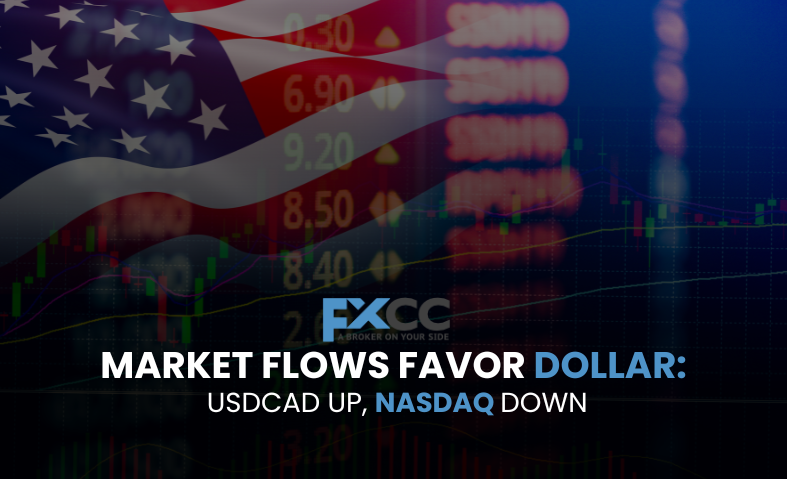Introduction
Global financial markets often move in cycles, influenced by economic data, investor confidence, and central bank policies. Over the past few sessions, market sentiment has favored the U.S. dollar, driving the USDCAD currency pair higher while simultaneously putting pressure on the Nasdaq index. This divergence highlights how money flows between safe-haven assets, currencies, and equities affect global investors and traders.
In this article, we will look at the reasons behind the stronger U.S. dollar, its impact on USDCAD, and why the Nasdaq is losing ground despite a generally stable economic backdrop.

Why the U.S. Dollar is Gaining Strength
The U.S. dollar has shown strong performance recently, supported by both domestic and global factors. Some of the key drivers include:
- Federal Reserve’s Policy Stance
Investors remain cautious about the Federal Reserve’s next move on interest rates. Even though inflation has cooled compared to last year, the Fed continues to signal that rates may remain higher for longer. Higher interest rates typically boost the dollar as they attract global investors seeking better returns on U.S. assets. - Safe-Haven Demand
Periods of uncertainty in global markets—whether from geopolitical tensions, trade disputes, or weak economic forecasts—often push investors toward the dollar. The greenback remains the world’s primary reserve currency, making it a safe choice during volatile times. - Stronger U.S. Economic Data
Recent reports on U.S. employment, consumer spending, and manufacturing have exceeded expectations. This signals resilience in the American economy, further supporting the dollar against its peers.
Impact on USDCAD
The USDCAD currency pair, which measures the U.S. dollar against the Canadian dollar, has moved upward in recent sessions. Several factors explain this shift:
- Oil Prices and the Canadian Dollar
The Canadian dollar is closely tied to crude oil prices because Canada is one of the world’s largest oil exporters. When crude prices decline, the Canadian dollar usually loses strength. Recently, concerns over slowing global demand and oversupply fears have weighed on oil markets, putting pressure on the Canadian dollar. - Interest Rate Gap
The Bank of Canada has taken a cautious approach compared to the U.S. Federal Reserve. While Canada is battling inflation as well, the Fed’s stronger stance has widened the interest rate gap in favor of the U.S. dollar. - Market Sentiment
As investors look for stability, they prefer holding U.S. dollars over risk-sensitive currencies such as the Canadian dollar. This shift has resulted in USDCAD climbing higher.
Nasdaq Under Pressure
While the U.S. dollar benefits from stronger demand, the Nasdaq index, which represents tech-heavy stocks, is under pressure. There are several reasons behind this decline:
- Higher Yields Hurt Growth Stocks
Rising interest rates often put extra pressure on technology and growth-focused stocks. When U.S. Treasury yields rise, the future cash flows of these companies are discounted at a higher rate, reducing their present value. This leads to weaker performance in the Nasdaq. - Profit-Taking After Strong Gains
The Nasdaq enjoyed a significant rally earlier in the year, fueled by enthusiasm around artificial intelligence, cloud computing, and other tech-driven themes. However, investors are now taking profits, especially as valuations look stretched in some sectors. - Stronger Dollar’s Negative Impact
A stronger dollar can hurt multinational companies listed on the Nasdaq because their overseas revenues are worth less when converted back into dollars. This currency effect has weighed on earnings outlooks, contributing to the recent weakness in the index.
Broader Market Sentiment
The movement in both USDCAD and the Nasdaq reflects a broader theme: capital is flowing into safer assets and away from riskier ones. Market participants are weighing future growth potential against immediate risks.
- Equities vs. Currencies
Equity markets, especially tech-heavy indices like the Nasdaq, are vulnerable to changing interest rate expectations. In contrast, the currency market often reacts more quickly to macroeconomic developments. This explains why the dollar is surging even as equities lose steam. - Global Investors Adjusting Portfolios
Asset managers worldwide are rebalancing portfolios to hedge against uncertainty. Shifting money into the dollar while trimming exposure to equities like the Nasdaq is a strategy that reflects cautious optimism but defensive positioning.
Short-Term Outlook
Looking ahead, the trends in USDCAD and Nasdaq will largely depend on upcoming economic data and central bank actions:
- For USDCAD: If oil prices remain under pressure and the Fed maintains a hawkish stance, the pair could continue to rise. However, any surprise strength in Canadian economic data or a rebound in crude oil could lend support to the Canadian dollar.
- For Nasdaq: The index could remain volatile as investors weigh earnings reports, interest rate signals, and global economic conditions. A softer inflation reading in the U.S. might provide relief, but higher-for-longer interest rates will likely limit significant rallies.
Bottom Line
The current market environment clearly shows how money flows are favoring the U.S. dollar, lifting USDCAD while dragging down the Nasdaq. Stronger U.S. economic data, safe-haven demand, and Federal Reserve policy are all reinforcing the dollar’s strength. Meanwhile, the Nasdaq is pressured by higher yields, profit-taking, and the currency impact on multinational earnings.

For traders and investors, the lesson is clear: global markets are interconnected. When the dollar rises, it doesn’t just impact currencies like the Canadian dollar but also affects stock indices like the Nasdaq. Keeping an eye on both sides of the market helps in making better trading and investment decisions.


